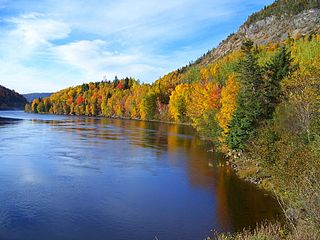
The Bay de Verde Peninsula is the largest peninsula that makes up part of the Avalon Peninsula, of the province of Newfoundland and Labrador, Canada. The peninsula separates both Trinity and Conception Bay.

Victoria is an incorporated town in Conception Bay located approximately midway on the Bay de Verde Peninsula of Newfoundland and Labrador, Canada.

The Burin Peninsula is a peninsula located on the south coast of the island of Newfoundland in the province of Newfoundland and Labrador.
Facheux Bay was the location of a small fishing settlement of the same name. In 1901 it had a population of 47. The community was also called Fachier, Facheaux, and Fouche. Facheux Bay is a deep fjord that separates Eastern Head and Western Head of Hermitage Bay, Newfoundland, Canada. Facheux bay is 2.25 miles (3.62 km) west of Mosquito Cove. The entrance is between two steep falls in high hills. The bay runs in 6.5 miles (10.5 km), with an average width of 0.75 miles (1.21 km), and has deep water throughout. On the west side are three coves with anchorage in 20 to 10 fathoms.

The Bonavista Peninsula is a large peninsula on the east coast of the island of Newfoundland in the Canadian province of Newfoundland and Labrador.

Hermitage Bay is an expansive bay stretching out along the south coast of Newfoundland. It is a body of Gulf of St. Lawrence which is near the Connaigre Peninsula. On its south, it is bordered by the Hermitage peninsula and the communities of Seal Cove, Hermitage and Sandyville. On its north side it is flanked by the communities of McCallum on mainland Newfoundland and by Gaultois on Long Island. Long Island separates Hermitage Bay from Bay d'Espoir farther inland to the north.
Chimney Bay is a natural bay located on the east coast of the Great Northern Peninsula, Newfoundland, Canada. It is one of two narrow indrafts of Canada Bay, the other being Bide Arm. The promontory that separates Chimney Bay from Bide Arm is moderately high. The south extreme is called Lard Point, from which the coast curves northwestward to Lard Cove, and then to Marten Point, the east point of the entrance to Chimney Bay. The bay extends nearly 7 miles (11 km) northeast from Marten Point, where it is .75 miles (1.21 km) wide. This coast is rugged and fringed by rocks.
Dragon Bay is a natural bay in Newfoundland, Canada. Indrafts include Mooring Cove, Willis Cove, Tickle Cove, and Crew Cove. Dragon bay runs in a westerly direction for more than 3 miles (4.8 km) from the entrance to Facheux Bay. It is narrow and deep throughout, with no anchorage. The south point of the entrance to this bay is Red Rock, the north point is Gray Rock, which has a cave. Little Hole lies 0.75 miles (1.21 km) west of Dragon Bay, and has shelter for small vessels.

La Poile Bay is a natural bay in Newfoundland, Canada, in the southwestern area of the island, off the south coast. It subdivides into Northeast Arm and North Bay. The settlement of La Poile is located on the bay.
Chaleur Bay is natural bay on the island of Newfoundland in the province of Newfoundland and Labrador, Canada. Its features include cliffs, ravines and waterfalls.
Connoire Bay is natural bay or cove on the island of Newfoundland in the province of Newfoundland and Labrador, Canada. Miffel Island is nearby.
Tickle Bay is a natural bay off the island of Newfoundland in the province of Newfoundland and Labrador, Canada.
Witless Bay is a natural bay off of the island of Newfoundland in the province of Newfoundland and Labrador, Canada. It is located on the eastern coast of the Avalon Peninsula, south of Bay Bulls and north of La Manche Provincial Park.
Carbonear Bay is a natural bay off the island of Newfoundland in the province of Newfoundland and Labrador, Canada. The bay is also home to Carbonear Island.

Spaniard's Bay is a natural bay off the island of Newfoundland in the province of Newfoundland and Labrador, Canada. It extends from Conception Bay into the northern section of the Avalon Peninsula.
Bay de Grave is a natural bay off the island of Newfoundland in the province of Newfoundland and Labrador, Canada.
Collier Bay is a natural bay off the island of Newfoundland in the province of Newfoundland and Labrador, Canada.
Barren Bay is a natural bay on the coast of Labrador in the province of Newfoundland and Labrador, Canada. It is nearby to West Island, Drunken Cove Point and Salmon Bight Point. Barren Bay is also close to Frenchman Cove, Fenchman Cove and Hauling Cove.

Division No. 1, Subdivision G is an unorganized subdivision on the Avalon Peninsula in Newfoundland and Labrador, Canada. It is in Division 1 and contains the unincorporated communities of Baccalieu Island, Besom Cove, Bradley's Cove, Burnt Point, Caplin Cove, Daniel's Cove, Grates Cove, Gull Island, Job's Cove, Kingston, Long Beach, Lower Island Cove, Low Point, Northern Bay, Ochre Pit Cove, Red Head Cove, Riverhead, Smooth Cove and Western Bay.
Division No. 1, Subdivision L is an unorganized subdivision on the Avalon Peninsula in Newfoundland and Labrador, Canada. It is in Division 1 and contains the unincorporated communities of Bareneed, Black Duck Pond, Blow Me Down, Coley's Point South, Hibb's Cove, Pick Eyes, Port de Grave, Ship Cove and The Dock







